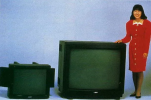Perhaps if they continued to invest in the tech, significant improvements could have been made. We may never know if LCD was a better route forward.Can you imagine the size and weight of CRTs with the size screens people are rocking nowadays though? "Just got my new 80" TV! Knocked out the wall into the neighbours' so we have a couple of feet in front of it."
You are using an out of date browser. It may not display this or other websites correctly.
You should upgrade or use an alternative browser.
You should upgrade or use an alternative browser.
Digital Foundry Article Technical Discussion [2024]
- Thread starter Shifty Geezer
- Start date
The bigger you go the bigger cathode ray tube you need, biggest ever made was apparently 45" Sony PVM-4300, which weights over 200 kg and is sized at 1050 x 727 x 925 mm. Generally 40" was deemed the max practical size.Perhaps if they continued to invest in the tech, significant improvements could have been made. We may never know if LCD was a better route forward.
Physics and big CRTs don't mix.
Is there no room for possibility that breakthroughs could have been made with the tech as our technology has advanced? Maybe they could have adapted lighter materials and different chemicals to accomplish the same result?The bigger you go the bigger cathode ray tube you need, biggest ever made was apparently 45" Sony PVM-4300, which weights over 200 kg and is sized at 1050 x 727 x 925 mm. Generally 40" was deemed the max practical size.
Physics and big CRTs don't mix.
To my understanding not really, it's the actual rays that require bulk of the space and the bigger screen you have, longer the tube will be.Is there no room for possibility that breakthroughs could have been made with the tech as our technology has advanced? Maybe they could have adapted lighter materials and different chemicals to accomplish the same result?
Maybe we could make them lighter by replacing the thick glass with something lighter but still strong enough to hold vacuum, but that should be about it.
It's random things like this that make me wish the multiverse existed.To my understanding not really, it's the actual rays that require bulk of the space and the bigger screen you have, longer the tube will be.
Maybe we could make them lighter by replacing the thick glass with something lighter but still strong enough to hold vacuum, but that should be about it.
The bigger you go the bigger cathode ray tube you need, biggest ever made was apparently 45" Sony PVM-4300, which weights over 200 kg and is sized at 1050 x 727 x 925 mm. Generally 40" was deemed the max practical size.
Physics and big CRTs don't mix.

As the distance from the emitter to the screen decreases, you start to get skew on the beam. Think of standing a ways off from a wall and shining a torch on it - you get a spot of light wherever you shine. Now stand right up against the wall and shine the torch around - it starts to deform from a spot to an oval/parabola. Then of course the shape of containing vacuum 'tube' gets thinner which is a less than ideal shape to contain the vacuum.To my understanding not really, it's the actual rays that require bulk of the space and the bigger screen you have, longer the tube will be.
Maybe we could make them lighter by replacing the thick glass with something lighter but still strong enough to hold vacuum, but that should be about it.
For the years the CRTs were a tech, there was incredible interest in making them smaller and lighter, but they found nothing. The only future tech could be something producing advanced beam forming that could control the shape in realtime (not outside the realm of possibility) but you still have the issue with the physical requirements. You would never get thin displays. Maybe an 80" would be something like a foot/30cms deep and weigh 50+ kgs. Power draw would probably be mammoth.
lol I had to disassemble my dad's CRT in the basement to move it out. Sooo heavy and large. I really don't think I can go back despite remembering it fondlyCan you imagine the size and weight of CRTs with the size screens people are rocking nowadays though? "Just got my new 80" TV! Knocked out the wall into the neighbours' so we have a couple of feet in front of it."
It could be a bad idea because lasers are generally coloured, maybe an IR/UV laser or a MASER (M stands for Microwave)
also you'd have to have an array of laser's as you cant steer photons the way you can steer electrons, you could use mirrors but then you'd need a lot of depth
plus I'm not sure how much heat those lasers would put out
also you'd have to have an array of laser's as you cant steer photons the way you can steer electrons, you could use mirrors but then you'd need a lot of depth
plus I'm not sure how much heat those lasers would put out
Last edited:
Riddlewire
Regular
They already exist.It could be a bad idea because lasers are generally coloured, maybe an IR/UV laser or a MASER (M stands for Microwave)
also you'd have to have an array of laser's as you cant steer photons the way you can steer electrons, plus I'm not sure how much heat those lasers would put out
They use mirrors.
https://en.wikipedia.org/wiki/Laser-powered_phosphor_display
While I agree with Alex that it would be nice to get rid of FPS as a metric for a game's performance or smoothness.. I still think it's the best way to show the typical viewer an easily quantifiable difference in performance between two or more platforms at any given second. MS and frametimes tells a better story for smoothness and consistency over time though obviously.
I'd say get rid of the FPS graph portion and just post the FPS of each platform in the top corner like Rich does in his reviews, and then have the frametime graph the entire length of the screen on the bottom.
I'd say get rid of the FPS graph portion and just post the FPS of each platform in the top corner like Rich does in his reviews, and then have the frametime graph the entire length of the screen on the bottom.
arandomguy
Veteran
Is there no room for possibility that breakthroughs could have been made with the tech as our technology has advanced? Maybe they could have adapted lighter materials and different chemicals to accomplish the same result?
There were newer technologies in the pipeline along similar development principles in -

Surface-conduction electron-emitter display - Wikipedia
Field-emission display - Wikipedia
But economically LCDs were always going to win out as LCDs fundementally benefit from overall semiconductor scaling in terms of costs and volume. This is why despite inflation you see LCD displays continually getting much bigger and better at similar cost levels at such high progression levels.
Products that primarily rely on mechanical manufacturing at that level of complexity and precision just face enourmous cost challanges. This is similarly why Micro LED displays at present do not really have a route to mass consumer cost levels (or it's just hidden in labs somewhere) even just in terms of theory much less implementation.
Unless maybe we get some sort of exotic technology breakthrough I guess with something like actual self directed nano technology in terms of assembly.
low framerate was very noticeable even on CRT. I used CRT screens until 2007 and I remember reducing the resolution of a rally game in 1997 'cos it looked choppy to me. However I got motion sickness at 320x240 when playing that game, at a higher resolution but low framerate I didn't experience it.It's bullshit that even the low FPS ran smoothly on the old CRT TV... I played a lot on PS1 and Xbox back then and 30 FPS was choppy compared to 60, I even noticed 25 compared to 30. Just like now on my LED TV. No difference.
And VRR is very good in many cases.
Another game where I experienced motion sickness was Heretic. I LOVED the concept of "medieval Doom" but I got motion sickness no matter what. Doom was ideal for me, but Heretic was a no go even if it uses teh same engine.
Good to know a lot of my guesses turned out to be correct, the need for a uv laser and the use of mirrors resulting in a deep displayThey already exist.
looking at them they are 25" 320x320 panels 19inches deep the seem to cost about $500 dont know what they cost at launch
They claim the panels produce very little heat and yet each panel has 2 fans on the back?
Last edited:
GhostofWar
Regular
arandomguy
Veteran
@Dictator What was the unity game you were using to show the physics issues that looked like rastan saga? the first of the 2 pixel art side scrollers. Cheers.

Actraiser Renaissance
Experience the revival of the 90's classic hit "Actraiser".
GhostofWar
Regular
Thanks, your a champ.
Actraiser Renaissance
Experience the revival of the 90's classic hit "Actraiser".www.square-enix-games.com
Yeah, CRT were not good. They need to be designed for a specific frame rate because you can't adjust the retention time of phosphors, so if a monitor is optimized for 60Hz, it'll have be blurry when doing 90Hz, and if a monitor is designed for 90Hz, it'll be flickering when doing 60Hz. Not to mention that CRT also have image retention problems, albeit probably less so than OLED. They are also very power hungry, and use dangerously high voltage electricity.
IMHO the only real advantage of CRT over modern display technologies is probably the much less defined horizontal resolution (so you can use different resolutions on the same display without too much artifacts), but that's less a problem today with high resolution displays, and AI scalers help a lot.
IMHO the only real advantage of CRT over modern display technologies is probably the much less defined horizontal resolution (so you can use different resolutions on the same display without too much artifacts), but that's less a problem today with high resolution displays, and AI scalers help a lot.
Similar threads
- Replies
- 5K
- Views
- 533K
- Replies
- 3K
- Views
- 397K
- Replies
- 4K
- Views
- 552K
